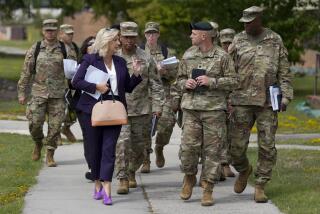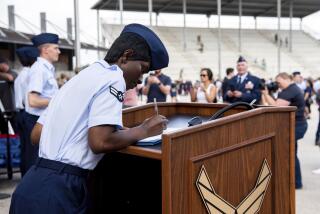Warriors at the limit
Today, Carter and Bay address the question that underlies nearly all foreign policy debates. Later in the week, they’ll debate the state of the armed forces today, mass conscription, the surge, and the leaner/meaner model of warfare.
Choose the right job or the right tool
By Phillip Carter
The answer to whether America needs a bigger military necessarily depends on the answer to another question: what kind of foreign policy do we want? In a March 2005 article for The Washington Monthly, I framed this question as a supply or demand choice: “It can be the world’s superpower, or it can maintain the current all-volunteer military, but it probably can’t do both.”
Today, we are trying to do both, and we are failing. America can no longer afford to run its steak-and-lobster national security strategy on a McDonalds budget, as it has done by pursuing wars in Afghanistan and Iraq, as well as many smaller deployments to places like Djibouti and the Philippines, with the anemic active-duty force we have today. America needs both a larger active-duty military for its current wars, and a larger reserve force capable of providing depth for these wars and the next.
The current force size flows from a model known as “1-4-2-1”, which means:
1) Defend the United States;4) Maintain forces capable of deterring aggression and coercion in four critical regions: Europe, Northeast Asia, Southwest Asia, the Middle East;2) Maintain a capability to combat aggression in two of these regions simultaneously;1) Maintain a capability to “win decisively”up to and including forcing regime change and occupationin one of those two conflicts “at a time and place of our choosing.”
There are many flaws in this model. First, it presumes that our enemies will fight us in series, rather than in parallel wars, and allow us the time we need. Second, it assumes that air and naval forces can effectively replace ground units when the Army and Marines are tied up elsewhere. But this model’s fatal flaw is that it fails to account for complex sustained wars, like those in Afghanistan and Iraq. As British Gen. Rupert Smith writes in The Utility of Force, such sustained conflictswhat he terms “war amongst people”are likely to become the new norm, replacing interstate industrial wars of discrete length.
Our active-duty Army and Marine Corps need at least 150,000 additional personnel to sustain the wars in Iraq and Afghanistan. The reserves need at least 200,000 more troops to sustain current efforts and have something in the cupboard for contingencies elsewhere, from North Korea to Darfur to the next domestic disaster. Some favor the creation of specialized units, like special forces and civil affairs, to fight more wars like Iraq in the future. I disagree. I think we need to enlarge the base strength of the military, and to make conventional units more capable of “full spectrum” operations, from humanitarian relief to counterinsurgency to major combat operations. We should prioritize people over hardware in the Pentagon budget, recognizing that the human element of warfare matters more now than ever.
A less ravenous foreign appetite could reduce these military needs, as could a safer world, but I’m skeptical we will see either soon. We must act quickly to develop the military we need to persevere in Iraq and Afghanistanand be ready for the next. As the proverb goes: The best time to plant a tree is 20 years ago; the second best time is today.”
Phillip Carter, an attorney with McKenna Long & Aldridge LLP in Los Angeles, is a former Army officer and an Iraq veteran.
Let the civilians in government step up
By Austin Bay
Phil, you frame the issue in terms of the foreign policy. I agree with your deeper purpose, which is to place the issue of the size of the military within the appropriate context. The military is only one of several “policy tools” and a truly useful discussion of the size of the military will consider its relationship with and synergy (or lack of synergy) with those other elements of power.
If we’re going to drill down to foreign policy druthers, then let’s also drill into the components of a foreign policy and how use (or misuse) of those policy tools affects the military.
We demand that our military win our wars, which means being proficient with weaponry running from bayonets to smart bombs. But we also force our military to competently use a trowel, auditing software, doctor’s bag, and agronomist’s soil analyzer, and to occasionally provide solid legal, political and investment advice. That’s been the military’s burden since 1992, when the Era of Peacekeeping replaced the Cold War. The 9/11 attacks replaced the Era of Peacekeeping with a global war over the conditions of modernity. I don’t believe you can withdraw from that war. Winning takes all elements of power applied in a sustained, focused (yet flexible) manner. However, the other governmental agencies simply haven’t done their part in the field. The military compensates by doing its own job and everyone else’s. These complex missions require resources and manpower.
(This Creators Syndicate column from last fall provides additional background to “unified action.”).
It’s 2007, and the Army and Marines have increased in size, especially when compared to the force projections from the 1990s. The big reason is 9/11, but by 1995 peacekeeping commitments had already begun stressing the system. The Clinton Administration used the Reserves as an operational force rather than as a strategic, war-winning reserve. That was judged an acceptable risk and a blanket condemnation of that decision would be silly. The personnel bind was the result of winning the Cold War. The US didn’t need its old Cold War base structure, and from what the Department of Defense could tell in 1990-94, the US didn’t need Cold War troop levels, either. Then we went into the Balkansand remain there. (In fact, the Army asked for a 30,000 troop increase in its FY 1997 budget, an increase in “end strength” for active duty troops.) Since 2001 we’ve nudged the Army from around 480,000 to 512,000darn close to the 30,000 “missing” since 1996 but far fewer than the forces on hand in August 1990.
In article for the San Antonio Express-News on August 26, 2001, I argued that we would need more ground troops. That’s pre 9/11, pre-Afghanistan, and pre-Iraq. The article addresses many of the issues we’ve both raised vis à vis pressure on the current force structure and provides useful background for this discussion.
What’s the correct size of the larger military we both believe we need? Until we get an expeditionary State Department and Department of Agriculture we will continue to give the military development missions. Nor do I see a foreign policy I “want” in the immediate future. I see a strong commitment to Iraq. Churchill took Hitler at his word, though Britain’s parliament didn’t; we should take Iran’s Ahmadinejad at his word as well. You advocate a bump of 150,000 between Army and Marines. Does that put the Army at 650,000 and Marines about 180,000? I’ll support those active duty end strengths.
For the record, in 1990 the Army fielded around 750,000 and the Marines about 197,000. (Scroll down through this article for numbers in 1990 and 1994.) Those are larger forces than you and I recommend todayand they were all volunteers. We’ll discuss a draft later in the week, but America had a population of 250 million in 1990. We have 300 million now. The absolute numbers and the percentages of troops in service compared to total population suggest the thesis of your 2005 article is suspect.
Austin Bay is an author and syndicated columnist. He is also a retired US Army Reserve colonel and an Iraq veteran.
Day 1 | |
More to Read
Sign up for Essential California
The most important California stories and recommendations in your inbox every morning.
You may occasionally receive promotional content from the Los Angeles Times.










